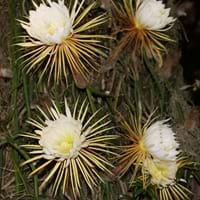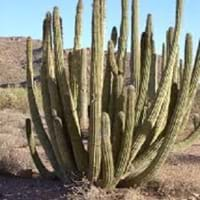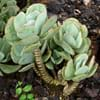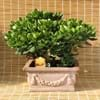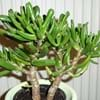Life Span
Perennial
Perennial
Type
Cactus, Flowering Plants
Cactus or Succulent
Origin
South America, Argentina, Brazil
Southwestern United States, Mexico
Types
Not available
Not Available
Habitat
Dry Forest, limestone outcrops, Subtropical climates
Dry areas, Hillside, Semi desert
USDA Hardiness Zone
10-14
Not Available
AHS Heat Zone
12-10
12-10
Sunset Zone
H2, 13, 16, 17, 21, 22, 23, 24
9, 10, 11, 12, 13, 14, 15, 16, 17, 18, 19, 20, 21, 23, 24
Habit
Upright/Erect
Clump-Forming
Flower Color
White, Light Green
White, Lavender
Flower Color Modifier
Bicolor
Not Available
Fruit Color
Orange, Pink, White, Yellow
Red
Leaf Color in Spring
Not Available
Not Available
Leaf Color in Summer
Not Available
Not Available
Leaf Color in Fall
Not Available
Not Available
Leaf Color in Winter
Not Available
Not Available
Leaf Shape
Not Available
Linear
Plant Season
Spring, Summer, Fall, Winter
Spring, Summer, Fall, Winter
Sunlight
Full Sun
Full Sun
Type of Soil
Loam, Sand
Loam, Sand
The pH of Soil
Acidic, Neutral, Alkaline
Neutral
Soil Drainage
Well drained
Well drained
Bloom Time
Late Spring, Early Summer
Not Available
Tolerances
Drought, Salt
Drought
Where to Plant?
Container, Ground
Ground, Pot
How to Plant?
Cuttings
Seedlings
Plant Maintenance
Medium
Medium
Watering Requirements
Average Water Needs, Distilled Water, Needs good drainage
Do not water frequently, Does not require lot of watering, Water occasionally
In Summer
Lots of watering
Lots of watering
In Spring
Moderate
Moderate
In Winter
Average Water
Average Water
Soil pH
Acidic, Neutral, Alkaline
Neutral
Soil Type
Loam, Sand
Loam, Sand
Soil Drainage Capacity
Well drained
Well drained
Sun Exposure
Full Sun
Full Sun
Pruning
Remove damaged leaves, Remove dead branches, Remove dead leaves
Remove damaged leaves, Remove dead branches, Remove dead leaves
Fertilizers
All-Purpose Liquid Fertilizer
All-Purpose Liquid Fertilizer
Pests and Diseases
Bacterial Stem Rot, Mealy bugs, Red spider mite, Scale
Red blotch
Plant Tolerance
Drought
Drought
Flower Petal Number
Semi-Double
Single
Foliage Texture
Bold
Bold
Foliage Sheen
Not Available
Not Available
Self-Sowing
No
Not Available
Attracts
Birds, Spider Mites
Hummingbirds
Allergy
Avoid during Pregnancy, hallucinations
Skin irritation, sneezing
Aesthetic Uses
Showy Purposes
Not Used For Aesthetic Purpose
Beauty Benefits
Not Available
Not Available
Environmental Uses
Air purification
Air purification
Medicinal Uses
Antidiabetic, Rheumatism, Soothing and relieving pain
Not Available
Part of Plant Used
Flowers, Leaves
Not Available
Other Uses
Traditional medicine, Used for its medicinal properties, Used in herbal medicines
Showy Purposes
Used As Indoor Plant
Yes
Yes
Used As Outdoor Plant
Yes
Yes
Garden Design
Container, Edible, Hedges, Houseplant, Rock Garden, Wall, Tropical
Container, Feature Plant, Houseplant, Rock Garden, Wall
Botanical Name
Selenicereus grandiflorus
STENOCEREUS thurberi
Common Name
Queen of the night, large-flowered cactus, sweet-scented cactus, vanilla cactus
Organ pipe Cactus
In Hindi
रात की रानी
Organpipe cactus
In German
Königin der Nacht
Organpipe cactus
In French
Reine de la nuit
Orgue cactus
In Spanish
Reina de la noche
Cactus del tubo de órgano
In Greek
Βασίλισσα της νύχτας
Εκκλησιαστικό όργανο κάκτος
In Portuguese
Rainha da noite
Cacto da tubulação de órgão
In Polish
Królowa nocy
Organ Pipe Cactus
In Latin
Domina noctis
Organum Pipe cactus
Phylum
Magnoliophyta
Not Available
Class
Magnoliopsida
Magnoliopsida
Order
Caryophyllales
Caryophyllales
Family
Cactaceae
Cactaceae
Genus
Selenicereus
Stenocereus
Clade
Angiosperms, Core eudicots, Eudicots
Angiosperms, Core eudicots, Eudicots
Tribe
Hylocereeae
Pachycereeae
Subfamily
Cactoideae
Cactoideae
Number of Species
Not Available
Importance of Queen of the Night and Organpipe Cactus
Want to have the most appropriate plant for your garden? You might want to know the importance of Queen of the Night and Organpipe Cactus. Basically, these two plants vary in many aspects. Compare Queen of the Night and Organpipe Cactus as they differ in many characteristics such as their life, care, benefits, facts, etc. Every gardener must at least have the slightest clue about the plants he wants to plant in his garden. Compare their benefits, which differ in many ways like facts and uses. The medicinal use of Queen of the Night is Antidiabetic, Rheumatism and Soothing and relieving pain whereas of Organpipe Cactus is Not Available. Queen of the Night has beauty benefits as follows: Not Available while Organpipe Cactus has beauty benefits as follows: Not Available.
Compare Facts of Queen of the Night vs Organpipe Cactus
How to choose the best garden plant for your garden depending upon its facts? Here garden plant comparison will help you to solve this query. Compare the facts of Queen of the Night vs Organpipe Cactus and know which one to choose. As garden plants have benefits and other uses, allergy is also a major drawback of plants for some people. Allergic reactions of Queen of the Night are Avoid during Pregnancy and hallucinations whereas of Organpipe Cactus have Skin irritation and sneezing respectively. Having a fruit bearing plant in your garden can be a plus point of your garden. Queen of the Night has showy fruits and Organpipe Cactus has showy fruits. Also Queen of the Night is not flowering and Organpipe Cactus is not flowering . You can compare Queen of the Night and Organpipe Cactus facts and facts of other plants too.
